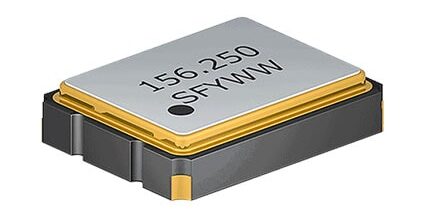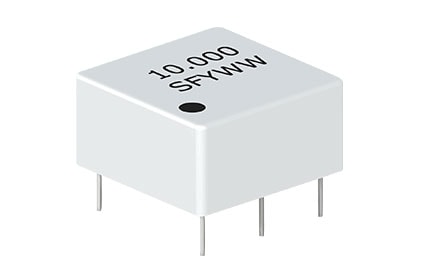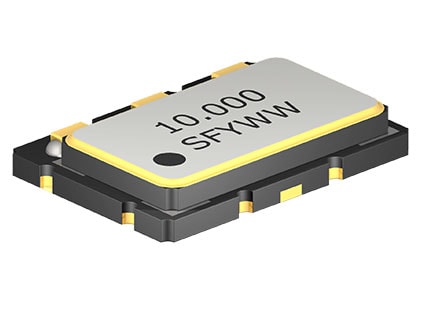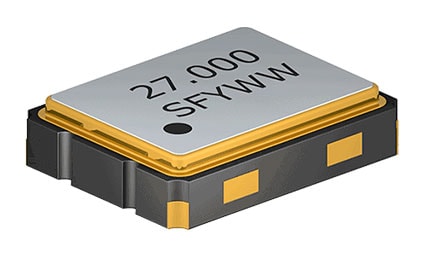Oscillators are incredibly important pieces of the electronics you use every day. Everything from video game consoles and appliances to stun guns and GPS has an oscillator. If it has a printed circuit board (PCB), it probably has an electronic oscillator. From humble beginnings in the 19th century by using electric arcs to create oscillation, these devices have developed through the years to produce stable frequencies that have become necessary for many of our electronics. In this post, we’ll be going over what oscillation is, what an oscillator is and touching on a few of the most common oscillator types that we offer at Suntsu.
Before we talk about how an oscillator works, let’s give a quick recap on what oscillation means. Oscillation is simply the movement of something back and forth at regular intervals. An example of this would be an old grandfather clock with a pendulum in it. As the pendulum swings, energy moves back and forth, from kinetic to potential, to keep the pendulum swinging. Oscillators are electronic circuits found in devices that work based on the principles of oscillation to produce an output signal that is consistent at a specific frequency. These frequencies can then be used to keep accurate time in devices or generate signals in computers and other electronics for other processes.
Oscillators work by converting direct current (DC) power to alternating current (AC) power. To do this, DC power is connected to the circuit which then flows through the oscillator circuit and becomes AC signals at specific frequencies that are called sine waves. These waves act as informational signals in electronics and, since it changes over time as it oscillates, they become integral in all devices that need accuracy.
Going back to the grandfather clock example, the pendulum will not swing infinitely as friction will cause the energy between swings to diminish. That is unless another force continues to add a little push to keep the oscillation going. Typically, this is done with a spring inside that coils and uncoils to push the pendulum a little bit on each swing, adding enough energy back in to keep it in motion.
The essential components contained within the oscillator circuit act like the spring and pendulum to keep the frequency stable and continuous. These parts of an oscillator are a frequency determining circuit (such as a crystal in crystal oscillators), an amplifier, and a positive feedback circuit. The frequency circuit, as the name suggests, determines the frequency of the oscillator. Like the spring in the example, the amplifier and feedback circuit keep the current continuously flowing as it gets increased by passing through the amplifier and then gets fed back into the frequency circuit, allowing the oscillator to be self-sustaining.
Block diagram of a feedback linear oscillator; an amplifier A with its
output Vo fed back into its input Vf through a filter, β(jω).
There are numerous types of electronic oscillators, but they can all be broadly broken down into two categories: non-linear (relaxation) oscillators and linear oscillators (harmonic). For non-linear oscillators, energy passes between the active and passive components, generating non-sinusoidal waveforms (such as saw-tooth, triangular or square). Frequency is determined by the time it takes for the energy to pass between the components, charging and un-charging them. In linear oscillators, energy flows from the active to the passive components, generating sine waves, or a sinusoidal output. The frequency of these oscillators is determined by the feedback path. The most used linear oscillators are called crystal oscillators. Below are a few examples of common crystal oscillators that we carry at Suntsu.

Crystal oscillators are electronic circuits that use the mechanical resonance of a vibrating crystal of piezoelectric material to create an electrical signal with precise frequency. Also referred to as waveform generators, oscillators produce continuous vibrations at specific frequencies varying from 32.768kHz to over 250MHz. The main role of an electronic oscillator is to take the analog signal from a clock source and convert it to a digital signal, typically rectangular, sine, or clipped sine wave, to operate an electronic device.
The benefits of crystal oscillators include:
| High Frequency Stability | Frequency Range | High Q (Quality) Factor | Low Phase Noise |
Crystal oscillators are commonly found in digital watches, smartphones, computers, radios, clocks, and many complex electronic systems such as military and aerospace communication systems.

An Oven Controlled Crystal Oscillator (OCXO), also known as a crystal oven, is considered a top performer for the precision of its frequency signals. These units contain built-in heaters and rely on above-normal heat levels to help stabilize and maintain a consistent temperature. To avoid variations in frequency and keep quartz crystals at a constant temperature, OCXO’s maintain their stability by running a temperature-controlled chamber. Because thermal insulation and a heater are required to warm the quartz crystals up to temperature, OCXOs are larger than other crystal units, but the thermal insulation serves as a protective shield from temperature fluctuations.
The benefits of OCXO’s include:
| Temperature Stability | Frequency Accuracy | Premium Performance | Frequency Aging |
OCXO’s are used to control the frequency of some of the most essential communications technology, such as radio transmitters, cellular base stations, military communications equipment, and in measurement applications where the highest frequency stability possible from crystals is needed.

A Temperature Compensated Crystal Oscillator (TCXO) is a specialized type of crystal oscillator that provides high levels of stability and accuracy when required for electronic devices. These units are commonly found in high-temperature environments and actively counteract the effect of any temperature variations that can affect the frequency stability of the oscillator. Temperature plays a role in what makes OCXO’s and TCXO’s unique, but they do have a slight difference. OCXO’s consist of an ‘oven’ that heats the crystal to a desired temperature so that external changes will not affect it. On the other hand, a TCXO adjusts the frequency of the oscillator using its temperature compensation circuit to identify temperature changes outside of range and initiate a frequency stability mechanism as a response.
The benefits of TCXO’s include:
| Temperature Stability | Frequency Accuracy | Small Package Size | Low Phase Noise |
TCXO’s are found in many applications due to their stability and accuracy in variant temperatures. Some examples are power supplies, medical equipment, clocks, satellite navigation, telecommunications, and wireless devices.

A Voltage Controlled Crystal Oscillator (VCXO) is a crystal oscillator that relies on a voltage control input to adjust the frequency, commonly referred to as “pulling,” generated by the oscillator’s crystal. The difference between a VCXO and traditional crystal oscillator is that a VCXO includes a diode to tune or alter the frequency of the oscillator’s crystal. The diodes, typically on either side of the crystal, pass an electrical charge (a voltage) across the crystal that tunes its oscillation frequency.
The benefits of VCXO’s include:
| Frequency Tuning Capabilities | High Q (Quality) Factor | Low Phase Noise | Frequency Stability |
VCXO’s are used in applications where you want to be able to fine-tune frequency while maintaining stability. They can be found in telecommunications, data communications, medical, military, aerospace, and other applications that meet high accuracy and stability requirements.
Oscillators have been called the heart of electronics for how vital they are in most consumer electronics and other communications technology. Understanding the basics of crystal oscillators and types of oscillators can help you decide which one best fits your specific build requirements. So, if you’re in need of an oscillator for your next project build but not sure which one to choose, reach out to one of our engineering experts today. We’re here to help you create what’s next!
Looking for more information or seeking to learn more about our product lines?
Give us a call or request a new quote today!